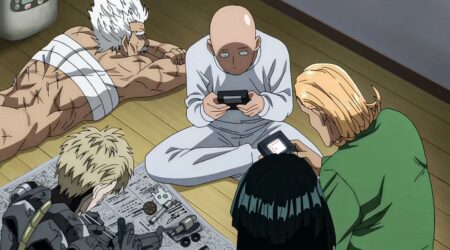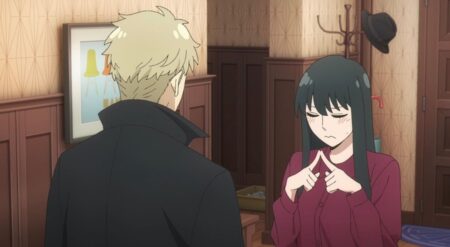
I have to be honest, I do not like “The Little Mermaid.” Something about a girl changing everything about herself to win a guy only to end up as seafoam crashing against the rocks in the end. So, I entered Bubble with a little apprehension. That said, the Netflix Original feature film from studio WIT, director Tetsurô Araki, and writer Gen Urobuchi offers a take on the fairy-tale that embraces hard science-fiction, romance, and enough whimsy and action to make the film shine.
After bubbles that broke the laws of gravity rained down upon the world, Tokyo has been cut off from everything. Surrounded by a large bubble, Tokyo has become a playground for a group of young people who have lost their families. Filled with rubble from an explosion that made the city uninhabitable, Tokyo is now a battlefield for parkour team battles as they leap from building to building. Hibiki, a young ace known for his dangerous playstyle, makes a reckless move one day and plummets into the gravity-bending sea. There, his life is saved by Uta, a girl with mysterious powers who appears suddenly. United by a unique sound audible only to them, their relationship begins a chain of events that will reshape the world.
To start, studio WIT has made a film that is visually breathtaking. With high-paced action sequences of characters free-running across a destructed landscape of bubbles and rubble, Bubble is continuously dynamic. There isn’t a single frame that sputters or loses quality no matter how fast the characters on screen are moving.
While this is a stunning feat from an action animation perspective, there are small elements, like when hair or clothes move in the wind, that showcases how detailed the team at WIT are in their creation of even the smallest moments. Add in the fact that the animation features blinding mixed medium elements around black holes and cosmic clouds, and Bubble is undeniably one of the most beautiful animated films I’ve seen, as well as some of WIT’s strongest work.
Whether it’s the fast-paced and intense parkour racing sequences or the character designs themselves (hooray for Hibiki’s crop-top), every bit of the world that WIT has created feels complete. Beauty is just one marker to judge an animated film by, and, unfortunately, other elements of Bubble don’t always land.

Having all lost their families, the boys who journey into Tokyo have found new ones with their parkour teams. Hibiki’s team, the Blue Blaze, are constant winners who have grown together in the city on a large boat. They train together, eat together, and are the only home that any of them know. Guided by two adults, this group is rife with material for exploration, especially since Hibiki’s sensitivity to sound has made him slow at feeling like family.
But instead of exploring the strings of found family and larger themes of belonging, the film chooses to embrace the magic around Uta. While it isn’t flat, it does miss the depth that could be explored. Maybe due to a short runtime, Bubble features many characters I immediately wanted to know more about, but I know I won’t get that chance.
For her part, Uta embodies elements of a manic pixie dream girl, blue hair and all. That said, she does develop a personality beyond Hibiki. She loves him and wants to be near him, but she also has her own identity and strength, impacting everyone around her. In her final act of love, it isn’t just for Hibiki, it’s for the life she’s had, the joy she’s experienced, and the people she met. In fact, Uta’s familial connection with the boys on the Blue Blaze is stronger than Hibiki’s, putting her into the center of the story with more than just romance revolving around her.
Given how I began this review, I’m incredibly impressed with how WIT has mapped “The Little Mermaid” into a unique science fiction narrative, with Uta speaking parts of the story as she experiences them. While it is on the nose, when coupled with the ethereal and wondrous bubble-scape in the film’s final act, it just works. The fairy-tale is a soft undercurrent for a larger more transformative story. Outside of the use of the fairy-tale, which is beautifully executed in the film’s final sequences, there isn’t much in way of thematic messaging.
We get a little on found family, some on competition, a little bit here and there about belonging, and apparently the death and birth of the universe with humanity’s evils thrown in, but none of it feels focused. There is a lot that Bubble tries to look at, both in its beginning credit sequence and in the aftermath of the climatic world-changing event in the third act.
That said, Bubble is visually some of WIT’s strongest work. It’s gorgeously animated with life breathed into every frame in a way that shows intention and an eye for creating an entire set and scene, not just one character. That beauty goes a long way, even when the story begins to lack. Bubble is wondrously beautiful and a unique take on a grim fairy-tale that ultimately offers up hope. Uneven in parts, I still completely recommend this title.
Bubble is streaming now, exclusively on Netflix
Bubble
-
Rating - 7/107/10
TL;DR
…Bubble is visually some of WIT’s strongest work. It’s gorgeously animated with life breathed into every frame in a way that shows intention and an eye for creating an entire set and scene, not just one character. That beauty goes a long way, even when the story begins to lack. Bubble is wondrously beautiful and a unique take on a grim fairy-tale that ultimately offers up hope.







